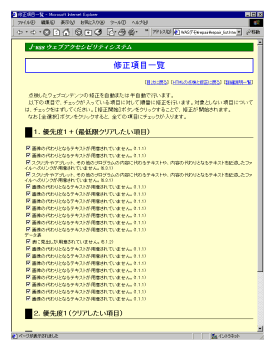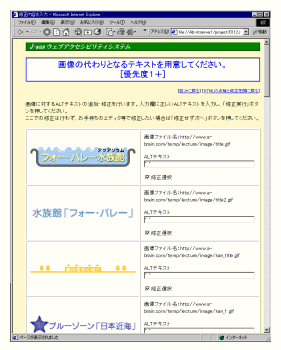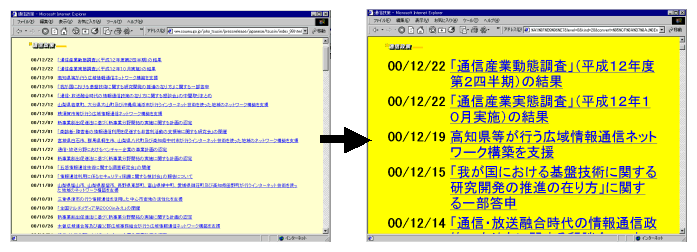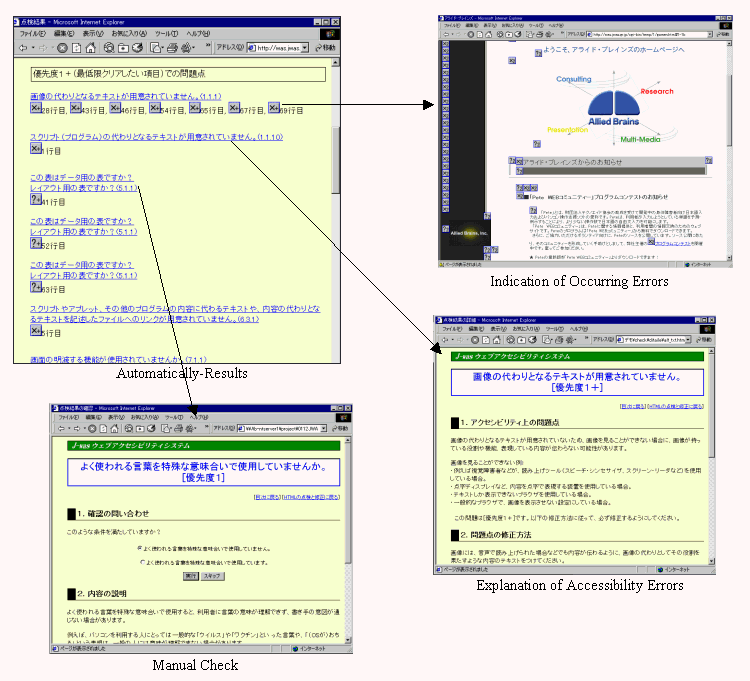トップページ ![]() 総務省実証実験について
総務省実証実験について ![]() Electronic Imaging 2002での発表
Electronic Imaging 2002での発表 ![]()
RESEARCH AND IMPROVING WEB ACCESSIBILITY IN JAPAN
Hitoshi Uchida (a), Masaya Ando (a), Kenji Ohta (b), Hirokazu Shimizu (c)
Yoshio Hayashi (d), Yasuyo G.Ichihara (e), Ryoji Yamazaki (f)
(a) Allied Brains, Inc., (b) Matsushita Electric Industrial Co., Ltd., (c) Communications Industry Association of Japan, (d) Keio-Gijuku Univ., (e) Dept.of Arts and Design, Hosen-Gakuen College, (f) Ministry of Public Management, Home Affairs, Posts and Telecommunications
Representative of authors: uchida@a-brain.com, phone +81-3-5285-1775; fax: +81-3-5285-3965; http://www.a-brain.com; Allied Brains, Inc., 2-20-15, Nishi-waseda, Shinjyuku-ku, Tokyo 169-0051, Japan
- 目次
- a. ABSTRACT
- b. CURRENT STATE OF WEB CONTENTS ACCESSIBILITY IN JAPAN
- c. JAPANESE MEASURES IN WEB CONTENT ACCESSIBILITY
- d. DISCUSSION OF AN ACCESSIBILITY EVALUATION METHOD MATCHING THE UNIQUE CHARACTERISTICS OF THE JAPANESE LANGUAGE
- e. DEVELOPMENT OF "J-WAS," THE JAPANESE WEB CONTENT ACCESSIBILITY SUPPORT SYSTEM
- f. IMPROVING WEB CONTENT ACCESSIBILITY THROUGH J-WAS
- g. CONCLUSION AND FUTURE ISSUES
- h. REFERENCES
a. ABSTRACT
Internet use by the people with disabilities and the elderly in Japan is still low, but growing. However, the majority of web contents written in Japanese, even government sites, have very low accessibility. This paper introduces the active measures being taken in Japan to improve such conditions; consideration of a web contents accessibility guideline tailored to the unique characteristics of the Japanese language, development of a system to evaluate accessibility and implementation of actual trials.
Keywords: Web Accessibility, Web Contents Accessibility Guideline, the Rehabilitation Act, Section 508
b. CURRENT STATE OF WEB CONTENTS ACCESSIBILITY IN JAPAN
1 Internet Use by the Elderly and Disabled
According to a data released by the Ministry of Public Management, Home Affairs, Posts and Telecommunications (Somusho), 34% of households were using the Internet in Japan in 2000, which was a significant 19% increase over the previous year. Furthermore, the number of jp domain web pages (public domain html files) available to the general public in Japan in March 2001 was approximately 60 million. The amount of information provided on these sites is greater than that provided by all the newspapers and magazines in Japan put together. These numbers reflect the increasing importance of the Internet in Japan as an info-communications medium and it has also brought attention to the issue of the digital divide between those who do not have accessibility to the Internet due to physical disabilities, age, or economic situations.
There are approximately 5 million people with disabilities living in Japan and according to data released by the Ministry of Public Management, Home Affairs, Posts and Telecommunications, their Internet dissemination rate was 7.8% in 1998, a much lower figure than for Japanese overall. There is significant difference in Internet use depending on the kind of disability, with over 10% of those with hearing and speech or language disability using the Internet, while only 3% with vision-related disabilities using the Internet.
Examples of tools assisting Internet use by the disabled are speech software which reads Japanese text aloud for those with vision disabilities, and easy-to-operate switches for those with difficulties in using their limbs. However, their availability is still insufficient. Yet, like the U.S., the Internet is a vital medium for gathering information and communications for the disabled who have found creative ways of using it.
At the same time, the Japanese population is aging quickly. Those over 65 in the year 2000 accounted for 17% of the total population indicating that Japan already has one of the highest levels of elderly residents in the world. The population is expected to age at an even faster pace, with the portion of the population over 65 growing by 10% in the next 20 years. Such rapid aging of the population is having an impact on the Internet. Internet use among the elderly is still low, but PC user groups for the elderly, "Senior Net", are being created all over the country. In ten years, the elderly will make up a significant portion of Japan's Internet users.
2 Assuring Accessibility of Japanese Web Sites
As Internet use increased among the disabled and elderly in Japan, there has also been greater focus on the lack of Japanese web content accessibility as a serious problem.
Fig.1 shows the number of problems found as a result of inspecting the top pages of Japanese web sites using the Web Contents Accessibility Guideline 1.0 (WCAG1.0), released by the World Wide Web Consortium (W3C). Upon inspecting 154 web sites, there was an average of 148 problems, reflecting the extremely low level of accessibility. Unlike the U.S. where a certain level of web content accessibility is required for federal government web sites by the Rehabilitation Act, Section 508, there is no accessibility among the central government sites of Japan.
Thus, Japanese web page accessibility is in a dire state, with many existing websites extremely difficult or impossible to use for the disabled and elderly.
Fig. 1: The Results of Accessibility for major Japanese Web Sites
c. JAPANESE MEASURES IN WEB CONTENT ACCESSIBILITY
1 Past Measures to Promote Web Content Accessibility
Of course, this is not to say that efforts in web content accessibility in Japan were nonexistent. WCAG1.0 was translated into Japanese by individuals and groups with an interest in accessibility and is available on the Web. Furthermore, several companies and private sector organizations have announced their own guidelines on accessibility and stressed the importance of assuring web content accessibility.
As for government measures, a Committee of the Ministry of Posts and Telecommunications (now the Ministry of Public Management, Home Affairs, Posts and Telecommunications) announced its policy on accessibility in 1999, which basically consisted of the same contents as WCAG1.0, and the Ministry of International Trade and Industry (now the Ministry of Economy, Trade and Industry) and its affiliated organizations have also conducted studies and research concerning web content accessibility.
2 Outstanding Issues from Past Measures
However, the guidelines on web content accessibility announced in Japan so far have no legislative backing or power of enforcement, only indicating objectives to which web designers voluntarily strive to achieve, and therefore, have not received sufficient attention.
Furthermore, there is no effective Japanese-compatible validation tool for accessibility and due to the innate differences between the English and Japanese languages, it is not possible to conduct an appropriate evaluation of Japanese web contents using WCAG1.0. These circumstances have made it difficult to create accessible Japanese web pages.
Most of all, the difficulties experienced by the disabled and elderly were seldom conveyed to web creators. Thus, without such understanding, the majority of web creators in Japan were not concerned with accessibility, but rather how to incorporate state-of-the-art technology to create more visually beautiful and entertaining web contents.
3 Actively Implementing Measures to Achieve Wide-Spread Acceptance of Web Content Accessibility
In order to improve the current state of web content accessibility, the Ministry of Public Management, Home Affairs, Posts and Telecommunications and the Communications Industry Association of Japan (CIAJ) have created the "Web Accessibility Working Group." Its major activities are:
- Discuss a new accessibility evaluation method, which takes into consideration the info-communications environment and unique characteristics of the Japanese language.
- Develop an accessibility evaluation system, which can be used in Japanese and is made to match the needs of the Japanese language.
- Improve web contents by implementing the newly developed evaluation system.
This paper will next introduce the progress made in these areas and their achievements.
d. DISCUSSION OF AN ACCESSIBILITY EVALUATION METHOD MATCHING THE UNIQUE CHARACTERISTICS OF THE JAPANESE LANGUAGE
1 Discussion of Basic Accessibility Evaluation Standards
WCAG1.0, recommended by the Web Accessibility Initiative (WAI), is currently the most widely used evaluation standard for web content accessibility. In order to determine more accurately whether or not an HTML document conforms to WCAG1.0, we have decided to apply the Techniques For Accessibility Evaluation And Repair Tools (AERT) a complimentary document to WCAG1.0. AERT is still a working draft, but it specifies the algorithm for evaluating whether or not an HTML document conforms to WCAG1.0.
However, the evaluation standard specified in AERT assumes that the text is written in the English alphabet. Therefore, if it is applied to web contents written in Japanese, appropriate evaluation or repairs are not possible. Such problems lead to the need for a new standard taking into consideration the unique characteristics of the Japanese language.
2 Revising AERT, With Consideration to Unique Characteristics of Japanese
The Web Accessibility Working Group concluded that the following items in AERT should be revised in order to make it compatible to the unique characteristics of the Japanese language.
- Changes in the guideline specifying appropriate length of the alternative text and sentences.
The Japanese phonetic alphabet and kanji characters (mostly originating from Chinese ideographic characters) are 2-byte characters, and with the diversity of characters, Japanese text requires very different characters to express an idea compared to English. Therefore, it is not appropriate to apply the guideline specified in WCAG1.0 as the evaluation standard of appropriate alternative text or sentences. It is necessary to create a separate standard for the Japanese language. - Changes in the standard due to differences in sentence construction (especially use of empty spaces)
Alphabet-based languages, starting with English, generally insert empty spaces in between words, but Japanese does not. WCAG1.0 evaluation guidelines include items based on the assumption that empty spaces are used. Therefore, is not appropriate for Japanese contents and an alternative standard for evaluation is needed.
3 Creation of a New Standard Matching the Unique Needs of the Japanese Language
Upon deliberation, the Web Accessibility Working Group concluded that changing the AERT standard to match the needs of the Japanese language would be insufficient and that a new standard is necessary to tackle the issues unique to the Japanese language. Major considerations are as follows:
- Need to consider the complexity of kanji characters
The Japanese language uses a unique combination of kanji characters and phonetic alphabet. The phonetic alphabet is limited to about 100 characters, but there are several thousand kanji characters used in everyday communications. Each of these characters are of different complexity, and even among native speakers of Japanese, the ability to read kanji characters differs according to such factors as age, generation, and educational background. Thus, Japanese people replace kanji characters with the phonetic alphabet for kanji characters they can't read. Therefore, in order to make Japanese content accessible, it is necessary to adjust the text format (balance of phonetic alphabet and kanji character use) to match the comprehension level of the user. - Need to consider the multiple ways of reading kanji characters
In Japanese, one kanji character can be read in several ways, and in some cases, they each have different meanings. For example, one Japanese character can be used to mean "direction" or "person," each with different phonetic readings. Therefore, with Japanese web contents, even if they satisfy all check points of WCAG1.0, cases will arise where the system cannot make the proper phonetic reading. One effective solution for a voice system to accurately read aloud written Japanese is to attach phonetic readings to every kanji character. However, there is no clear consensus in Japan on how to use this method of attaching phonetic readings to kanji characters.
4 Importance for Web Content Accessibility Guideline to Take into Consideration the Diversity of a Language
Many of the issues mentioned in this section are unique to the Japanese language, but there is a high possibility that such unique problems arise when applying WCAG1.0 to languages not using the English alphabet. The Internet is an open network with information in numerous languages. Therefore, it is vital that any web content accessibility guideline be flexible enough to cover these various unique linguistic characteristics.
e. DEVELOPMENT OF "J-WAS,"
THE JAPANESE WEB CONTENT ACCESSIBILITY SUPPORT SYSTEM
1 Three Functions of "J-WAS"
"J-WAS" is a system for improving Japanese web content accessibility, with the three functions "accessibility evaluation & repair," "access assistance," and "experiencing accessibility first-hand." (Fig.2)
J-WAS exists in a server connected to the Internet, with the user using it as on-line software when accessing the Internet from their PC via the J-WAS server's browser. (Fig.3, 4)
Fig. 2: Three Functions of "J-WAS"

Fig. 3: "J-WAS" LOGIN (Screen Shot)

Fig. 4: "J-WAS" Menu (Screen Shot)
2 Outline of Accessibility Evaluation and Correction Functions
The central functions of J-WAS are accessibility inspection and repair functions. It is expected to be widely used by web creators in Japan as a tool, which semi-automatically inspects the accessibility of random web pages, and when necessary, provides a correction process for problems. The contents of the evaluation is based on WCAG1.0, but it is the result of independent deliberations with a total of 112 evaluation items, encompassing the unique characteristics of the Japanese language mentioned in section 3, and widespread dissemination of browser-phones.
Furthermore, all evaluation results are explained in Japanese and as for accessibility level, web pages are evaluated and ranked into four levels. Considering the current state of web content accessibility in Japan, a new fourth level for web pages with the most basic functions was added to the three levels established in WCAG, making it easier for web creators in Japan to use J-WAS. (Fig.5, 6, 7)
Fig. 5: Description of Results of Evaluation

Fig. 6: Modification List

Fig. 7: Forms of Modification
3 Outlines of Access Assistance Functions
Access assistance functions aim to assist elderly and disabled Internet users. Once users register their personal traits and respective requirements, J-WAS will display web pages tailored to the wishes of the users whenever they access the web. For example, it can automatically magnify characters, change the color contrast between the background and text, add explanations to difficult vocabulary, and automatically change the layout to one without frames. Once a user registers the changes he/she wants made, they will be done automatically and in real-time every time the user looks at web pages.(Fig.8)

Fig. 8: Example of Access Assistance Functions
4 Outlines of Experiencing Accessibility First-hand Functions
The last function, experiencing accessibility first-hand, provides functions and contents to general web users that allows them to understand the concept of web content accessibility and specific problems currently existing on the web. For example, they can hear an auditory description of a web page (in order to listen to the reading, it is necessary to access J-WAS by telephone), and experience a simulation of how a text browser page is seen by a disabled person. By using these functions, users who previously had little interest in web content accessibility can gain an understanding of the web user environment for the visually disabled, and see for themselves the large number of web pages which cannot be read.
f. IMPROVING WEB CONTENT ACCESSIBILITY THROUGH J-WAS
1 Objective of Actual Trials
We have currently made J-WAS available to the public through the Internet and are promoting actual trials in order to improve accessibility of Japanese web contents.
There are two objectives to actual trials. One is to have as many people as possible of various situations use J-WAS and thus, evaluate the effectiveness of J-WAS functions and determine areas, which require further improvement. These improvements would be made by the spring of 2002, at which time the new version of J-WAS is scheduled to be made available to the public again for further evaluation.
The other objective for actual trials is, by having as many people as possible use J-WAS, to stimulate interest in web content accessibility in Japan and to increase the number of accessible Japanese web sites. As part of this objective, we are asking for the cooperation of many businesses and organizations which provide information on the web, starting with the Japanese government, local governments, major private sector companies, the mass media, and organizations for the disabled, and presenting the functions and uses of J-WAS to them.
2 Implementation Process
Preparations for actual trials are currently underway in three regions in Japan as model cases, in cooperation with major local businesses, local governments, civic organizations, and organizations for the disabled or elderly. In these regions, web site providers use J-WAS to evaluate the accessibility of their own web sites, while local users also evaluate the user friendliness of the web sites within their user environment. The creators and the users then directly share the results of their inspection/evaluation in an exchange meeting. At this meting, there are discussions on the problems of each web site and the necessary improvement measures, with the web site providers making adjustments accordingly. The revised web pages are again evaluated by the users, who monitor how much the user friendliness of the pages has improved.
The underlying reason for creating such a process is that web contents which are easy to use for the elderly and the disabled can not always be realized with evaluations and repairs based on accessibility evaluations specified in standards such as J-WAS. For example, even if alternative text is provided for image data it is often difficult for the web providers to judge whether the alternative text is adequate. In order to create truly accessible web contents, a process of contents revision is vital, where the web creators go directly to the elderly and the disabled to understand their user environment and hear their views and demands themselves, and not just think about accessibility in their heads.
Actual trials aim to create a model for effectively improving web content accessibility, which includes human aspects of the process, and hopefully will contribute to future measures.
g. CONCLUSION AND FUTURE ISSUES
This paper introduces the measures we are currently implementing in order to improve web content accessibility in Japan. We have pointed out the importance of a standard for web content accessibility evaluation which is compatible with the unique characteristics of the Japanese language.
A standard for accessibility which is compatible with the unique characteristics of the Japanese language has not been finalized yet. It is a continuing process.
We will continue with our current pursuits, making efforts to complete an accessibility evaluation and repair system which is compatible to the unique characteristics of the Japanese language.
h. REFERENCES
- Ministry of Public Management, Home Affairs, Posts and Telecommunications: "Information and Communications in Japan," White Paper, pp4-6, 2001
- World Wide Web Consortium (W3C), Techniques For Accessibility Evaluation And Repair Tools, http://www.w3.org/TR/AERT
![]() 「Electronic Imaging 2002での発表」に戻る(y)
「Electronic Imaging 2002での発表」に戻る(y)
by (C)情報通信研究機構 バリアフリーサイト, all rights reserved. barrierfree@nict.go.jp


